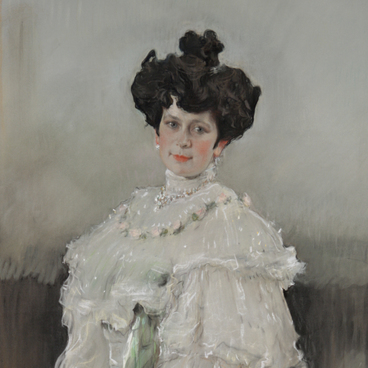The Russian icon-painting masters borrowed a lot from their Byzantium ancestors. After Christianity was adopted at the end of the 10th century, the Byzantium icons started to appear in Ancient Rus – they were not only worshipped but also imitated. However, the 12th century saw an inception of the Russia’s own icon painting school.
Kirik and Iulitta was painted by an unknown artist on the cusp of 17th and 18th centuries. It falls into the category of hagiographical icons: there is the image of a saint in the center with the pictures showing scenes from his/her life spaced along the margins.
The master painted a Christian woman Iulitta with her three-year-old son Kirik. According to the hagiography, Iulitta was a young widow of noble Roman origin who lived in Iconium. As the persecution unrolled during the reign of the Roman Emperor Diocletian, she left all the property behind, took her three-year-old son and, with two female slaves as her entourage, fled Iconium. At first, she settled in Seleucia and then moved to Tarsus.
In Tarsus Iulitta was recognized and with her son brought before the ruler of the city Alexander to whom she admitted being a Christian. The son was taken from her and she was flogged. Seeing his mother’s torments, Kirik first burst into tears but then proclaimed himself a Christian too and demanded access to his mother. Alexander became furious and threw the child from a stone platform killing him.
Iulitta was subjected to new tortures but she refused to offer sacrifice to the pagan gods. Alexander sentenced the saint to beheading, and the sentence was carried out. The executioners left the bodies of the mother and the son unburied outside the city, but Iulitta’s slaves secretly buried them in the night.
During the rule of Emperor Constantine the Great, the relics of Kirik and Iulitta were found thanks to one of the salves who buried the saints. The relics were moved to Constantinople where a monastery was found to commemorate them.
According to the 12th - 15th century, pilgrims the relics of the saints were kept in Hagia Sophia. Nobody knows what happened to them after the fall of Constantinople. The old believers worshipped Kirik and Iulitta as the patron saints who, just like themselves, were persecuted for their faith. On the Kirik and Iulitta memory day, the old believers felt obligated to go to church and offer payers to the saints asking for family well-being and healthy children. Iulitta, being a female saint patron, was asked to provide protection and support in their griefs and sorrows.
Kirik and Iulitta was painted by an unknown artist on the cusp of 17th and 18th centuries. It falls into the category of hagiographical icons: there is the image of a saint in the center with the pictures showing scenes from his/her life spaced along the margins.
The master painted a Christian woman Iulitta with her three-year-old son Kirik. According to the hagiography, Iulitta was a young widow of noble Roman origin who lived in Iconium. As the persecution unrolled during the reign of the Roman Emperor Diocletian, she left all the property behind, took her three-year-old son and, with two female slaves as her entourage, fled Iconium. At first, she settled in Seleucia and then moved to Tarsus.
In Tarsus Iulitta was recognized and with her son brought before the ruler of the city Alexander to whom she admitted being a Christian. The son was taken from her and she was flogged. Seeing his mother’s torments, Kirik first burst into tears but then proclaimed himself a Christian too and demanded access to his mother. Alexander became furious and threw the child from a stone platform killing him.
Iulitta was subjected to new tortures but she refused to offer sacrifice to the pagan gods. Alexander sentenced the saint to beheading, and the sentence was carried out. The executioners left the bodies of the mother and the son unburied outside the city, but Iulitta’s slaves secretly buried them in the night.
During the rule of Emperor Constantine the Great, the relics of Kirik and Iulitta were found thanks to one of the salves who buried the saints. The relics were moved to Constantinople where a monastery was found to commemorate them.
According to the 12th - 15th century, pilgrims the relics of the saints were kept in Hagia Sophia. Nobody knows what happened to them after the fall of Constantinople. The old believers worshipped Kirik and Iulitta as the patron saints who, just like themselves, were persecuted for their faith. On the Kirik and Iulitta memory day, the old believers felt obligated to go to church and offer payers to the saints asking for family well-being and healthy children. Iulitta, being a female saint patron, was asked to provide protection and support in their griefs and sorrows.



